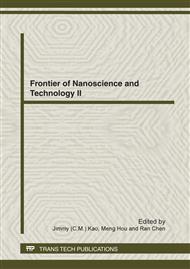p.130
p.135
p.140
p.144
p.152
p.156
p.160
p.164
p.168
Investigation of Precipitation in a Aging Hardened Plastic Mould Steel
Abstract:
The aging hardened plastic mould steel 10Ni3MnCuAl after aging at 510 °C is investigated by scanning electron microscope (SEM), transmission electronic microscope (TEM) and three dimensional atom probe (3DAP). The results show that its microstructure is granular bainite after soluted. Its aging hardening is mainly due to the precipitation of a high density, nanoscale and fully coherent NiAl precipitation with the B2 structure for 4 h. Clusters associated precipitates from 3DAP results show that its aging hardening derives from multicomponent precipitate containing Fe, Ni, Al, Mn and Cu, and concentration of Fe decreases with the aging time, while that of Ni, Al, Mn and Cu are opposite, and the ratio between Ni and Al are roughly 1.
Info:
Periodical:
Pages:
152-155
Citation:
Online since:
June 2012
Authors:
Keywords:
Price:
Сopyright:
© 2012 Trans Tech Publications Ltd. All Rights Reserved
Share:
Citation:


